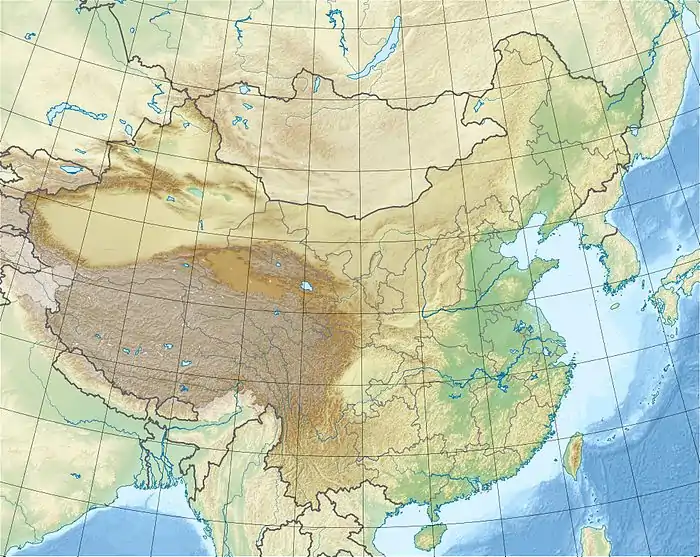Darriwilian
The Darriwilian is the upper stage of the Middle Ordovician. It is preceded by the Dapingian and succeeded by the Upper Ordovician Sandbian stage. The lower boundary of the Darriwilian is defined as the first appearance of the graptolite species Undulograptus austrodentatus around 467.3 million years ago. It lasted for about 8.9 million years until the beginning of the Sandbian around 458.4 million years ago.[6]
| Darriwilian | |
|---|---|
| 467.3 ± 1.1 – 458.4 ± 0.9 Ma | |
| Chronology | |
Epochs in the Ordovician -485 — – -480 — – -475 — – -470 — – -465 — – -460 — – -455 — – -450 — – -445 — – Epochs of the Ordovician Period. Axis scale: millions of years ago. | |
| Etymology | |
| Name formality | Formal |
| Usage information | |
| Celestial body | Earth |
| Regional usage | Global (ICS) |
| Time scale(s) used | ICS Time Scale |
| Definition | |
| Chronological unit | Age |
| Stratigraphic unit | Stage |
| Time span formality | Formal |
| Lower boundary definition | FAD of the Graptolite Undulograptus austrodentatus |
| Lower boundary GSSP | Huangnitang Section, Huangnitang Village, Changshan, Zhejiang, China 28.8539°N 118.4897°E |
| GSSP ratified | 1987[4] |
| Upper boundary definition | FAD of the Graptolite Nemagraptus gracilis |
| Upper boundary GSSP | Fågelsång section, Sularp Brook, Skåne, Sweden 55.7137°N 13.3255°E |
| GSSP ratified | 2002[5] |
Naming
The name Darriwilian is derived from Darriwil, a parish in County of Grant, Victoria (Australia). The name was proposed in 1899 by Thomas Sergeant Hall.[7]
GSSP

The GSSP of the Darriwilian is the Huangnitang Section (28.8539°N 118.4897°E) near the village Huangnitang, 3.5 km southwest of Changshan County Town (Zhejiang, China). It is an outcrop of the Ningkuo Formation, consisting of mainly black shale. The lower boundary of the Darriwilian is defined as the first appearance datum of the graptolite species Undulograptus austrodentatus in that section.[8]
A Secondary fossil marker is the graptolite Arienigraptus zhejiangensis.[8]
Biostratigraphy
The base of the Darriwilian is also the base of the Undulograptus austrodentatus graptolite zone. This zone lies just above the North Atlantic Microzarkodina parva conodont zone. The base also lies in the upper part of the North American Histiodella altifrons conodont zone.[8]
The Undulograptus austrodentatus graptolite zone is known from outcrops around the world, making the base of the Darriwilian easily correlatable.[9]
Regional stages
The Darriwilian overlaps with the upper Arenig and the Llanvirn.[10] The base of the Darriwilian can be correlated with a level in the Fennian stage of the Arenig.[8]
Palaeontology
Agnathans
| Agnathans of the Darriwilian | ||||
|---|---|---|---|---|
| Taxa | Presence | Location | Description | Images |
| Dapingian-Sandbian | Sacabamba, Cochabamba Department, Bolivia; Horn Creek Siltstone, Australia; Argentina; Oman | |||
Endocerids
| Endocerids of the Darriwilian | ||||
|---|---|---|---|---|
| Taxa | Presence | Location | Description | Images |
| Dapingian-Homerian | ||||
| Dapingian-Hirnantian | ||||
| Dapingian-Darriwilian | Chazy Reef Formation, New York, USA | |||
| Dapingian-Darriwilian | West Spring Creek, Oil Creek Limestone, Oklahoma | |||
| Dapingian-Darriwilian | ||||
| Tremadocian-Darriwilian | ||||
References
- Wellman, C.H.; Gray, J. (2000). "The microfossil record of early land plants". Phil. Trans. R. Soc. B. 355 (1398): 717–732. doi:10.1098/rstb.2000.0612. PMC 1692785. PMID 10905606.
- Korochantseva, Ekaterina; Trieloff, Mario; Lorenz, Cyrill; Buykin, Alexey; Ivanova, Marina; Schwarz, Winfried; Hopp, Jens; Jessberger, Elmar (2007). "L-chondrite asteroid breakup tied to Ordovician meteorite shower by multiple isochron 40 Ar- 39 Ar dating". Meteoritics & Planetary Science. 42 (1): 113–130. Bibcode:2007M&PS...42..113K. doi:10.1111/j.1945-5100.2007.tb00221.x.
- Lindskog, A.; Costa, M. M.; Rasmussen, C.M.Ø.; Connelly, J. N.; Eriksson, M. E. (2017-01-24). "Refined Ordovician timescale reveals no link between asteroid breakup and biodiversification". Nature Communications. 8: 14066. doi:10.1038/ncomms14066. ISSN 2041-1723. PMC 5286199. PMID 28117834.
It has been suggested that the Middle Ordovician meteorite bombardment played a crucial role in the Great Ordovician Biodiversification Event, but this study shows that the two phenomena were unrelated
- Mitchell, C.; Xu, Chen; Yuan-dong, Zhang; ZhI-hao, Wang; Webby, B.; Finney, S. (September 1997). "Definition of a global boundary stratotype for the Darriwilian Stage of the Ordovician System". Episodes. 20 (3): 158–166. Retrieved 13 December 2020.
- Bergström, Stig; Finney, S.; Xu, Chen; Pålsson, Christian; Zhi-hao, Wang; Grahn, Yngve (June 2000). "A proposed global boundary stratotype for the base of the Upper Series of the Ordovician System: The Fågelsång section, Scania, southern Sweden". Episodes. 23 (2): 102–109. doi:10.18814/epiiugs/2000/v23i2/003. Retrieved 13 December 2020.
- "GSSP Table - Paleozoic Era". Geologic Timescale Foundation. Retrieved 30 November 2012.
- Mindat.org
- "GSSP for Darriwilian Stage". Geologic Timescale Foundation. Retrieved 30 November 2012.
- Mitchell, C. E.; Chen Xu; S. M. Bergström; Zhang Yuan-dong; Wang Zhi-hao; B. D. Webby; S. C. Finney (1997). "Definition of a global boundary stratotype for the Darriwilian Stage of the Ordovician System" (PDF). Episodes. 20 (3): 158–166. doi:10.18814/epiiugs/1997/v20i3/003. Retrieved 20 September 2012.
- Gradstein, F. M., ed. (2012). The Geologic Time Scale 2012. Elsevier Science Ltd. p. 1176. ISBN 978-0444594259. Retrieved 30 November 2012.